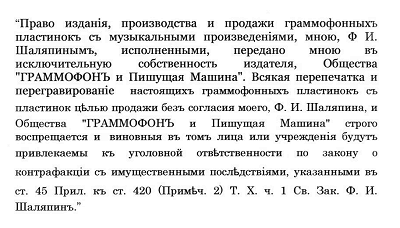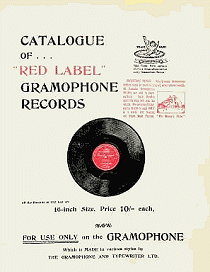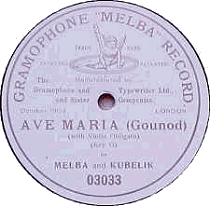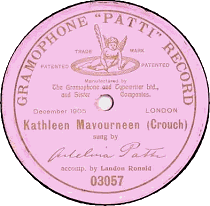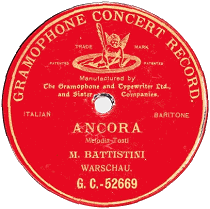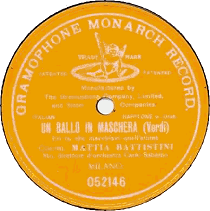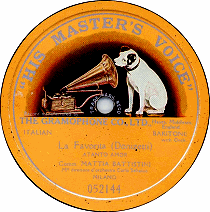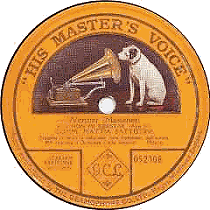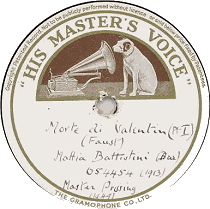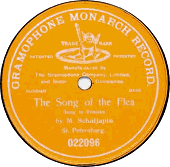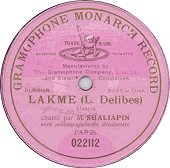The
Red Label Celebrity Series
In
his autobiography Fred Gaisberg relates
that the Figner recordings made in St.
Petersburg in 1900 were to have been
the first Gramophone Company discs issued
with red Celebrity labels with gold
lettering. However, he says also that
the red label was not introduced until
April 1901, and since Figner’s first
recordings were made in December 1901,
Fred’s memory failed him once more!
Fred made some 454 7-inch recordings
and about one hundred of the new 10-inch
recordings in St. Petersburg, Moscow,
and Kazan between March 25 and early
July 1901, returning to London for most
of the remainder of the year. Sinkler
Darby arrived in St. Petersburg from
Vienna in late November or early December
1901, when the Red Label series was
introduced to indicate the more outstanding
performers of the day, e.g., Figner,
his wife Medea, and Vialtzeva in late
1901, Chaliapin, Sobinov and Damaev
in 1902, and others. All to be sold
at double the usual price! In his Russian
Catalogue, Bennett indicates by underlining
the catalog number, that Figner’s December
1901 7-inch recordings were Red Label
issues. A 7-inch Red Label Figner G&T
22601 was listed in Lawrence Holdridge’s
auction catalog for 2003/4. As a further
comment, in his biography of Fred Gaisberg
Moore states that "Darby had made
the first discs destined for the Red
label in Russia during the previous
winter; for these he had secured the
great Figner and his wife Medea Mei."
Two of Nicolai Figner’s Red Label Celebrity
7" records, 22601 and 22605, may
be found on Symposium Record’s CD 1058,
Emile Berliner 100 Years.
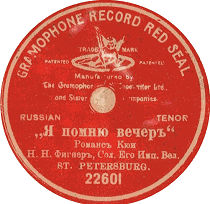
7-inch
Gramophone 22601, December 1901
Darby
began his second series of recording
sessions in St. Petersburg on December
3, 1901. These included seven 7-inch
and eight 10-inch recordings by Anastasia
Dmitrievna Vialtzeva, as well as six
7-inch and sixteen 10-inch recordings
by Nicolai Figner, all of which were
processed as Berliner discs at the Hanover
plant about December 17, 1901. When
the Red Label was finally agreed upon
by Theodore Birnbaum and Nicolai Rodkinson,
the manager of the Russian Branch, the
Vialtzeva and Figner pressings were
reissued from the Riga plant in early
1902 with the first Red Label, or at
that time Red Seal. The figure above
may possibly be the label on the first
Red Label Celebrity issue released by
the Gramophone Company. Note the phrase
RED
SEAL,
which
was dropped shortly. Lawrence Holdridge
has confirmed that at one time he listed
one of Vialtzeva’s 7-inch Red Label
discs with a similar label.
The
following quotation by Peter Adamson,
entitled A
Scarlet Woman
and intended as a jest, is taken from
The Hillandale News, Number 173, April
1990, page 27.
"Many
collectors will be aware that after
the coming of the famous Red G &
T label on 10" discs, some of
the most prestigious 7" Berliner
discs were converted to this high
status by having the central area
of the stampers flattened to allow
labels to be included in the pressing
process. Figner and Vialtzeva were
the lucky ones in Russia, and there
were also some slightly later examples
of the 7" Gramophone Record Red
Seal (as it was called) ─ Primo
Vitti in 1902 for example. As a keen
collector of early 7" records,
I eagerly note anything of this sort
which is out of the ordinary. So it
is all the more surprising for me
to find that I should have had for
many years, without realizing it,
a 7" Red Berliner! It is (naturally)
A Russian disc made in St. Petersburg,
and issued in June 1901 [sic] with
catalogue number 23072. On it, a soprano
with a rather plummy voice sings a
typical Russian song entitled ‘Under
the spell of your caresses.’ [Под
периодом
вашей
нежности]
But the oddest thing about this disc
─ in fact the only really notable
thing ─ is the lady’s name.
Having by now become accustomed to
seeing such esoteric things as Davidov
Berliners, Morskoi Berliners, Figner
Berliners, I was quite amused to find
that I had indeed managed to acquire
a RED Berliner. The matrix number,
although obscure, seems to be 2558,
recorded around the beginning of April
1901 ─ possibly the 1st. The
singer’s name? Madame G.L. Red…"
A
final quotation is from Leonard Petts’
report of the September 1979 meeting
of the City of London Phonograph and
Gramophone Society:
"The
7-inch Red Label discs were issued
in May 1902, but some had been recorded
in November [sic] 1901 and issued
with Berliner labels….The records
we heard (listed on the next page)…."
Among
the list mentioned above were Vialtzeva’s
7" Red G. & T. 23089 and Figner’s
10" Red G. & T. G.C.-22549.
The
important fact to note here is, that
while numerous 10-inch recordings were
made in Russia and elsewhere following
the introduction of the new technique
in April 1901, most of those destined
to be issued with red label in the new
Celebrity series were probably issued
initially as Berliners.. This is confirmed
in Peter Adamson’s paragraph shown above.
The
Gramophone Company, with the single
exception of the first issues, never
used the phrase RED SEAL, but always
RED LABEL, as shown on the catalog cover
below. The Victor Company applied for
a trademark for the phrase RED SEAL
on July 20, 1904, which was registered
on August 30, 1904. However their first
Red Seal labels were not used until
March 1903, when they reissued some
twenty-five G&T recordings in their
new 5000 series. To quote from Michael
Sherman, "Following the lead of
their British affiliates, they adopted
the Red label for these 10" releases."
The
cover of the first Red Label Catalogue
issued by the Gramophone Company in
1902 is shown on the left above. Featuring
Madame Emma Calvé, who made her
first G&T recordings in July 1902,
the listed records sold for ten shillings
or $2.50 each. This catalogue must have
listed over 250 Red Label Celebrity
recordings, which would have been available
before September 1902. The cover on
the right shows the February 1904 Catalogue,
which includes supplements for September,
October, and November. The available
discs of some seventeen artists are
listed, mostly with their photographs.
The listings of all but two artists,
Francesco Tamagno and Leonid Sobinov,
have the prefix R.L. for Red
Label, rather than G.C. for Gramophone
Concert shown on their issued labels.
Nearly all of the 51 so-called London
Red G&Ts of 1902 are listed, with
the exception of those of David Bispham.
Of
the 237 discs listed in the February
catalog, all but those of Tamagno were
again priced at 10 shillings. Tamagno’s
records were sold for £1 or $5 each.
Only eighteen of Caruso’s twenty 1902
recordings were listed, the two remakes
having been omitted. The September 1904
supplement includes eleven Victor recordings
issued with G&T catalog numbers
and bearing the prefix V.M. for both
10- and 12-inch discs. The artists included
Caruso, Mario Ancona, Emma Albani, Fyodor
Chaliapin, Anastasia Vialtzeva, Nicolai
and Medea Figner, Campanari, Pol Plançon,
Antonio Scotti, the celebrated violinist
Jan Kubelik, as well as the choir and
quartet of singers of the Sistine Chapel
of the Vatican in Rome.
The
superb work of Alan Kelly shows that
the first Red Label Celebrity series
issue was introduced in December 1901
for Nicolai Figner’s recording G.C.-22547
(see also above). The great baritone
Maurice Renaud was the first French
artist to receive this recognition,
while Caruso, Plançon, De Luca,
De Lucia, Ancona, and Scotti followed.
Less well known but equally outstanding
artists, including Maria Michailova,
and the renowned violinist Jan Kubelik
(who was given Red Label status before
February 1904), and Pablo de Sarasate,
were issued with black labels. Red Label
G&T’s are found as late as October
1906, at about which time the color
was changed to pink, for the "super-celebrity"
artists. A completely different shade
of red was used later for the HMV labels.
At the same time a slightly smaller
trademark was introduced, the Angel
being 27 mm wide instead of 30 mm.
Celebrities
such as Dame Nellie Melba were occasionally
accorded a label color of their own
choosing, hers being mauve (actually,
lilac), usually with her facsimile signature,
as seen above. In March 1904, in the
drawing room of her mansion on Great
Cumberland Place in London and under
the supervision of Fred Gaisberg, Melba
recorded 16 arias. She was probably
the only and last artist ever to be
allocated her own unique block of matrix
numbers, viz., 1 – 28. One condition
for her recordings was that the issued
records have a distinct and unique label
color. G&T 03033 below was from
her second recording session in October
1904, when she was accompanied by the
great violinist Jan Kubelik. This recording
bears the matrix number 401c, her unique
matrix number series having been abandoned.
Melba would remake this selection for
Victor in New York in early February
1905.
|
|
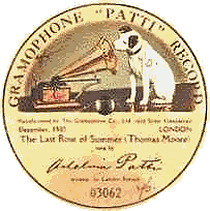 |
Adelina
Patti’s first recordings were made at
her castle at Craig-y-Nos, near Penwylt
in Wales, by Fred Gaisberg with his
brother Will as his assistant. This
was in December 1905, when Madame Patti
was sixty-three years old. Patti was
accorded pink labels, together with
her facsimile signature. Her insistence
on the pink color forced the Gramophone
Company to introduce pink as a "super-celebrity"
color, which was duly instituted in
1907. Caruso, Ruffo, Plançon,
and Farrar were among the other artists
appearing on pink labels. Both sopranos
were given labels with their names in
the phrasing above either the Angel
or the Dog trademark, viz., GRAMOPHONE
"MELBA" RECORD and GRAMOPHONE
"PATTI" RECORD. Both their
labels show replicated signatures. The
Gramophone issues of both Melba and
Patti are among the few labels that
indicate the recording dates.
|
|
|
|
G.C.-52669,
stamper II
|
GM
052146
|
Mattia
Battistini’s first recordings made in
Warsaw in February 1902 were issued
with Red Celebrity labels. The disc
on the top left above is the last of
the ten recordings in his first session.
The recordings made in 1906, illustrated
by the disc on the top right above,
were accorded orange labels with silver
lettering, since gold lettering would
not show up well. Note the various shades
of orange below. The courtesy of the
orange label also extended to Battistini’s
Russian labels. Both discs above were
recorded in Warsaw in November 1906.
|
|
|
|
Milan,
November 1906
|
|
|
|
|
Milan,
HMV 052308
June 2, 1911
|
Master
pressing, HMV 054454
June 3, 1913
|
|
|
|
|
Milan,
June 6, 1913 Chaliapin’s second
G&T recording
Moscow,
January 23-28, 1902
|

Sticker
in Russian, similar to Victor stickers
of the period
The
sticker above is found on the reverse
of all of Chaliapin’s early G&T
recordings. It relates specifically
to Chaliapin and his exclusive rights
under copyright laws. The sticker reads
as follows:
